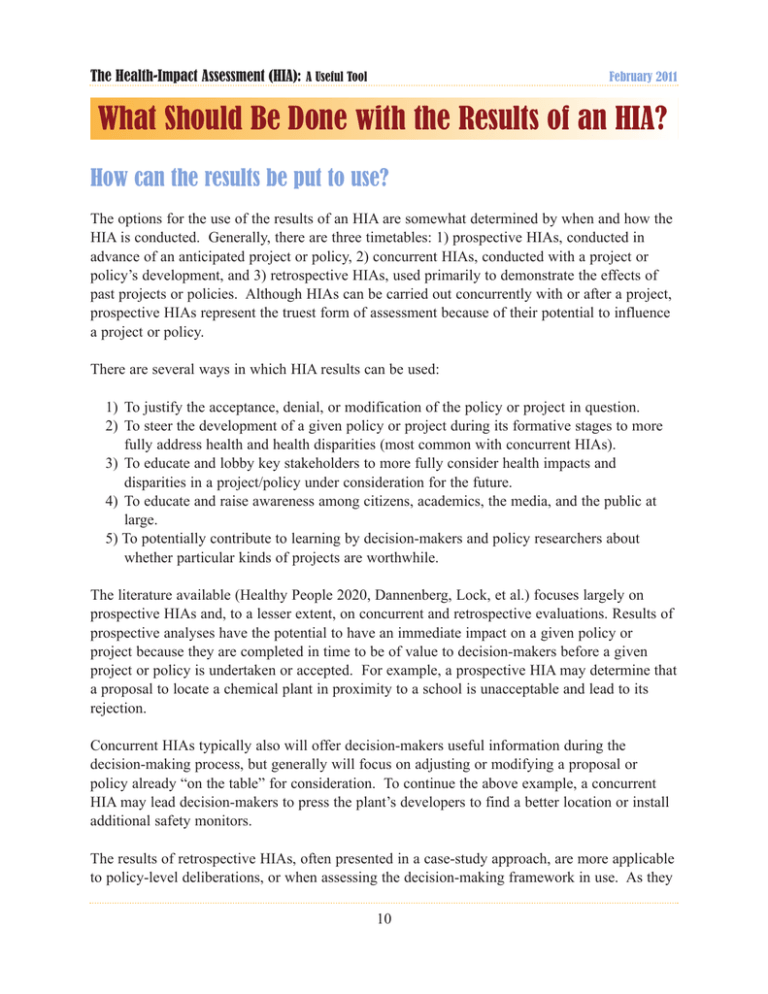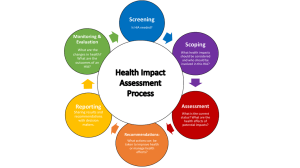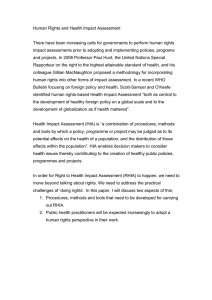What Should Be Done with the Results of an HIA?
advertisement

The Health-Impact Assessment (HIA): A Useful Tool February 2011 What Should Be Done with the Results of an HIA? How can the results be put to use? The options for the use of the results of an HIA are somewhat determined by when and how the HIA is conducted. Generally, there are three timetables: 1) prospective HIAs, conducted in advance of an anticipated project or policy, 2) concurrent HIAs, conducted with a project or policy’s development, and 3) retrospective HIAs, used primarily to demonstrate the effects of past projects or policies. Although HIAs can be carried out concurrently with or after a project, prospective HIAs represent the truest form of assessment because of their potential to influence a project or policy. There are several ways in which HIA results can be used: 1) To justify the acceptance, denial, or modification of the policy or project in question. 2) To steer the development of a given policy or project during its formative stages to more fully address health and health disparities (most common with concurrent HIAs). 3) To educate and lobby key stakeholders to more fully consider health impacts and disparities in a project/policy under consideration for the future. 4) To educate and raise awareness among citizens, academics, the media, and the public at large. 5) To potentially contribute to learning by decision-makers and policy researchers about whether particular kinds of projects are worthwhile. The literature available (Healthy People 2020, Dannenberg, Lock, et al.) focuses largely on prospective HIAs and, to a lesser extent, on concurrent and retrospective evaluations. Results of prospective analyses have the potential to have an immediate impact on a given policy or project because they are completed in time to be of value to decision-makers before a given project or policy is undertaken or accepted. For example, a prospective HIA may determine that a proposal to locate a chemical plant in proximity to a school is unacceptable and lead to its rejection. Concurrent HIAs typically also will offer decision-makers useful information during the decision-making process, but generally will focus on adjusting or modifying a proposal or policy already “on the table” for consideration. To continue the above example, a concurrent HIA may lead decision-makers to press the plant’s developers to find a better location or install additional safety monitors. The results of retrospective HIAs, often presented in a case-study approach, are more applicable to policy-level deliberations, or when assessing the decision-making framework in use. As they 10 The Health-Impact Assessment (HIA): A Useful Tool February 2011 are completed after-the-fact, their results are useful for program evaluation or as policy background for similar future deliberations. A retrospective HIA would have had no impact on the plant’s location or operation. It would serve to illustrate the likely health risks now facing the community and call into question the decision-making of the agencies charged with oversight. It could also be useful as evidence for future decisions about the location of industrial uses in proximity to schools. How can it be ensured that results are heeded? In the U.S. at present, HIAs are generally not a regulatory requirement. Simply put, there are few rules or laws that would force a decision-making body to consider, or act upon, the recommendations of an HIA in the same way it is compelled to comply with more traditional assessments like an environmental-impact study. How then can one maximize the likelihood that a HIA is fully considered by decision-makers and that its results are put to effective use? In short, how can decision-makers come to see the value of the HIA process and the analyses’ recommendations? In its 2008 Health Impact Assessment: Quick Guide, The National Association of County and City Health Officials (NACCHO) makes several key suggestions—valuable evidence, engagement across disciplines, and spill-over into arenas outside of health and planning. Valuable evidence – The report suggests that the evidence presented must not only be valid and defensible, but that the recommendations and findings must be relevant to the decision-making body. For example, an analysis presented to a town council favoring parks and trails would likely be better received if it were able to highlight health and lifestyle benefits likely to accrue to the town. An HIA noting possible ramifications to the national healthcare system would be less applicable. Cross-disciplinary engagement – The strength and, frankly, the challenge of the HIA process is its inclusiveness and comprehensive scale. It necessitates input and cooperation from a broad range of stakeholders. To continue the above example, a town council may choose to disregard a recommendation for a new park and trails from its public works committee. However, that same council would be far less likely to disregard a recommendation studied and made jointly by public works, parks and recreation, planning, public health, and a homeowner’s association. Spill-over into arenas outside of health and planning – Though the primary function of an HIA is to determine potential health outcomes, it need not be limited to them. Rarely are decisions made in a vacuum. In the park/trails example, the town council may like the idea but be weighing the property’s potential use for a municipal building or water-treatment plant as well. An inclusive analysis that also details economic benefits, perhaps one that illustrates 11 The Health-Impact Assessment (HIA): A Useful Tool February 2011 higher property values (and thus higher property tax revenues) in proximity to parks and trails, would be easily as persuasive as the health benefits. The inclusion of various subgroups that could be affected by a proposal, in this case developers and homebuilders, is highly recommended. Residents, advocacy groups, civic organizations, and like-minded legislators are an excellent starting point. Andrew Dannenberg’s analysis of 27 HIAs highlights the importance of inclusivity and timely availability of results (Use of Health Impact Assessment in the U.S.: 27 Case Studies, 19992007, Dannenberg et al.). Timeliness, as already discussed, is clearly paramount. An analysis performed after a decision has been reached, or after a project or policy has already cleared other regulatory or statutory hurdles is, in all likelihood, less likely to be as carefully considered. Legislators, city councils, government agencies, and private entities all work on their own unique, often regimented, schedules. An analysis that does not fit into the timetable of the process risks being excluded from it. The inclusivity of the HIA process is also pertinent. In Dannenberg’s case studies, he describes a broad range of approaches. These ranged from mandated and codified assessments that were purposefully built into regulatory requirements to those conducted by outside consultants or interest groups. Some were subject to intense public vetting and engagement, while others resembled academic exercises, conducted in insular environments. In either instance, a pivotal factor (also noted prominently in the NACCHO report) was a multi-disciplinary approach and participation from potentially affected groups. Perhaps predictably, Dannenberg’s research showed that the impact of an HIA’s conclusions roughly correlated to the number of stakeholders (a.k.a. constituents) that were involved in the process—from having a direct bearing on the issue at hand to being largely ignored, or similarly, “taken under review” by the deciding body. He also recommends broad dissemination and/or publication of the analysis to ensure decision-makers can be held publically accountable. 12



